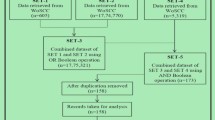Abstract
In this paper, we use bibliometric methods and social network analysis to analyze the pattern of China–US scientific collaboration on individual level in nanotechnology. Results show that Chinese–American scientists have been playing an important role in China–US scientific collaboration. We find that China–US collaboration in nanotechnology mainly occurs between Chinese and Chinese–American scientists. In the co-authorship network, Chinese–American scientists tend to have higher betweenness centrality. Moreover, the series of polices implemented by the Chinese government to recruit oversea experts seems to contribute a lot to China–US scientific collaboration.







Similar content being viewed by others
References
Beaver, D. B., & Rosen, R. (1978). Studies in scientific collaboration. I. The professional origins of scientific co-authorship. Scientometrics, 1(1), 65–84.
Borgatti, S. P. (2002). NetDraw: Graph visualization Software. Harvard: Analytic Technologies.
Bozeman, B., & Corley, E. (2004). Scientists’ collaboration strategies: Implications for scientific and technical human capital. Research Policy, 33(4), 599–616.
Chen, H., Kostoff, R. N., Chen, C., Zhang, J., Vogeley, M. S. E., Börner, K., et al. (2009). AI and global science and technology assessment. IEEE Intelligent Systems, 24(4), 68–88.
Davidson Frame, J., & Carpenter, M. P. (1979). International research collaboration. Social Studies of Science, 9(4), 481.
Glänzel, W., & De Lange, C. (2002). A distributional approach to multinationality measures of international scientific collaboration. Scientometrics, 54(1), 75–89.
He, T. (2009). International scientific collaboration of China with the G7 countries. Scientometrics, 80(3), 571–582.
Jin, B., & Rousseau, R. (2005). China’s quantitative expansion phase: exponential growth but low impact. In P. Ingwersen & B. Larsen (Eds.), ISSI 2005: Proceedings of the 10th international conference on scientometrics and informetrics. Stockholm.
Katz, J. S., & Martin, B. R. (1997). What is research collaboration? Research Policy, 26(1), 1–18.
Kostoff, R. N., Briggs, M., Rushenberg, R., Bowles, C. A., Icenhour, A. S., Nikodym, K. F., et al. (2007a). Chinese science and technology? Structure and infrastructure. Technological Forecasting and Social Change, 74(9), 1539–1573.
Kostoff, R. N., Koytcheff, R. G., & Lau, C. G. Y. (2007b). Global nanotechnology research metrics. Scientometrics, 70(3), 565–601.
Luukkonen, T., Persson, O., & Sivertsen, G. (1992). Understanding patterns of international scientific collaboration. Science, Technology and Human Values, 17(1), 101.
Melin, G. (2000). Pragmatism and self-organization: Research collaboration on the individual level. Research Policy, 29(1), 31–40.
Meyer, M., Debackere, K., & Glänzel, W. (2010). Can applied science be ‘good science’? Exploring the relationship between patent citations and citation impact in nanoscience. Scientometrics, 85(2), 527–539.
Newman, M. E. J. (2001). Scientific collaboration networks. I. Network construction and fundamental results. Physical Review E, 64(1), 1–8.
Newman, M. E. J. (2004). Coauthorship networks and patterns of scientific collaboration. Proceedings of the National academy of Sciences of the United States of America, 101(Suppl 1), 5200.
Tang, L., & Shapira, P. (2011). China–US scientific collaboration in nanotechnology: Patterns and dynamics. Scientometrics, 88(1), 1–16.
Acknowledgments
The research is supported by the project of “Social Science Foundation of China” (Grant No. 10CZX011), the project of “Specialized Research Fund for the Doctoral Program of Higher Education of China” (Grant No. 2009041110001), as well as the project of “Fundamental Research Funds for the Central Universities” (Grant No. DUT10RC(3)021).
Besides, we really appreciate the great help from two anonymous reviewers, especially one of whom offered many specific suggestions for linguistic improvements.
Author information
Authors and Affiliations
Corresponding author
Rights and permissions
About this article
Cite this article
Wang, X., Xu, S., Liu, D. et al. The role of Chinese–American scientists in China–US scientific collaboration: a study in nanotechnology. Scientometrics 91, 737–749 (2012). https://doi.org/10.1007/s11192-012-0693-x
Received:
Published:
Issue Date:
DOI: https://doi.org/10.1007/s11192-012-0693-x




